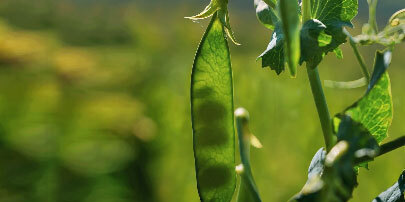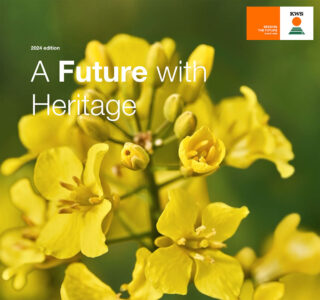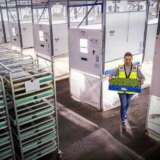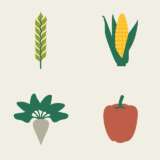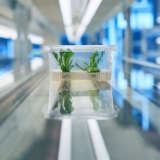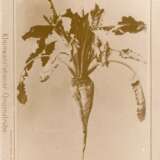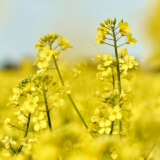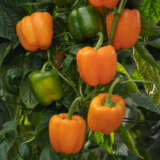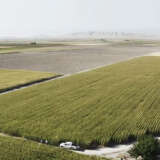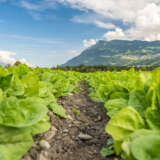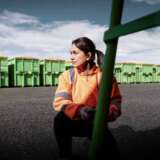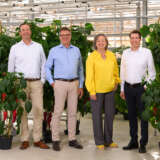#OneStepAhead
At the heart of oilseed rape breeding
The underlying conditions for agriculture in general and oilseed rape cultivation in particular are changing. While pests and diseases are on the rise, regulations on the use of pesticides are becoming increasingly stricter. Combine this with predicted increases in extreme weather events as well as the need to ensure adequate food supplies and achieve business objectives, it is clear that farmers are faced with a number of conflicting demands. KWS’s breeding programs in France and Germany show how successful breeding advances can reduce the use of resources and make crops more resistant.
Andreas Gertz | Responsible for the continental oilseed rape breeding program
Dr. Andreas Gertz is really pleased. The reason for the senior oilseed rape breeder’s delight may look a little strange to the untrained eye. There are large funnels hanging in a contraption above liquid-filled cups. In these cups, you can see larvae. It is the small number of insects that he has detected using the Berlese funnel method (see info graphic) that makes Andreas Gertz so happy – because the presence of fewer larvae means that the breeders have fulfilled their task. After all, the small and seemingly harmless creatures swimming in the liquid inside the cups are one of the biggest enemies of oilseed rape: The larvae later develop into cabbage-stem flea beetles. Despite their name, they have nothing to do with fleas, but are normal beetles that rank among the pests that KWS’s oilseed rape breeders seek to control.
Oilseed rape can be used to produce both vegetable oil for human consumption and biofuel. What’s more, protein-rich oilseed rape meal can be fed to cattle, ensuring that the protein in their feed comes from regional sources.
Andreas Gertz | Responsible for the continental oilseed rape breeding program
Andreas Gertz knows a lot about the merits of oilseed rape. He has been working for KWS since 2002 and is now responsible for the continental oilseed rape breeding program. As an important part of the crop rotation between cereal crops, oilseed rape offers great advantages in terms of soil quality and subsequent crops. Its dense growth of leaves suppresses weeds, prevents the field from drying out too much and protects the soil from erosion. In addition, oilseed rape is not only useful from an ecological point of view, but also offers many advantages as a crop. “Oilseed rape can be used to produce both vegetable oil for human consumption and biofuel. What’s more, protein-rich oilseed rape meal can be fed to cattle, ensuring that the protein in their feed comes from regional sources,” explains Gertz.
Increasingly limited use of insecticides
At the same time, oilseed rape farmers face challenges: From sowing to harvesting, the crops are under constant attack from pests such as the cabbage-stem flea beetle. The beetles feed on the seedlings or the first leaves of the newly germinated plants. They then lay their eggs next to the plants, and the larvae that hatch from these eggs feed on the leaf stalks and other parts of the oilseed rape plants during the winter. This means that insecticide treatments are necessary. However, the use of insecticides is increasingly being restricted by regulations, and certain products are losing their effectiveness.
This is precisely where KWS comes in with its breeding solutions: One of the aims of the Sustainability Ambition 2030 is to reduce the use of inputs such as pesticides. In view of a growing world population and the ever more severe consequences of climate change, it remains important to safeguard and maximize crop yields.
Excellent genetics provide natural protection
As with other plants, the challenge when breeding oilseed rape is that the mechanisms developed only offer selective protection. What works against one species of beetle has little effect on another. This makes the search for solutions more complex. Andreas Gertz has dedicated himself to this intensive search for solutions while keeping a realistic view of the pest situation: “The cabbage-stem flea beetle is a serious problem for plants.” Effective seed treatment solutions for the problem of adult beetles infesting leaves in summer are still in their infancy. Although such infestations are rare in Germany, Gertz reports having seen massive damage in the UK, France and Poland. “So far, no genetic material has been found that allows oilseed rape to develop resistance or tolerance to the adult insect,” explains Gertz, adding that ongoing breeding programs are still in the early stages.
Better safe than sorry: Berlese funnel method
However, thanks to its extensive breeding expertise and foresight, KWS has succeeded in developing what it calls InsectPROTECT varieties, which offer strong genetic protection against the second round of damage caused by the larvae. Three varieties in particular – namely FELICIANO KWS, KWS DEMOS and KWS AMBOS – have shown themselves to be superior to comparable varieties, exhibiting up to 30% less infestation by cabbage-stem flea beetle larvae. The plants thus enjoy natural protection. With InsectPROTECT, KWS is currently the only breeding company in the world to offer varieties that demonstrably reduce the number of larvae.
Small guy, big pest: KWS is working on innovative solutions to actively combat the cabbage-stem flea beetle.
High pest pressure from beetles in oilseed rape cultivation
The approach to breeding resistant varieties is divided into several steps. “In the case of the cabbage-stem flea beetle, for example, the first step consists of a complex screening process to identify genetic material that is less susceptible to the pest,” explains oilseed rape breeder Gertz, before going on to describe the subsequent steps: “This material must then be crossed with high-yielding varieties. Afterwards, we use the Berlese funnel method that I described earlier to examine the offspring of these crosses for the number of larvae and the degree of plant infestation, so that we can select the best lines.”
Oilseed rape cultivation is in dire need of further breed-ing advances, because two other species of beetle, the rape stem weevil and the rape winter stem weevil, are putting pressure on oilseed rape. KWS is actively addressing the challenges associated with oilseed rape through two breeding programs for maritime and continental regions: one in Mons-en-Pévèle in northern France and the other in Einbeck in Germany.
Resistance genes as milestones
For an example of the ongoing race among breeders to counter the yield losses caused by diseases – and of how KWS is maintaining the upper hand in this race – we need look no further than the advances made in combating Phoma lingam. This fungal infection, which causes root neck and stem rot, is a major problem in oilseed rape cultivation. Breeding has made it possible to develop varieties that are no longer heavily affected by the disease. The foundation for this is laid by varieties that exhibit a basic tolerance and are equally effective against all variants of the harmful fungus. Another important step in this process is to add new, different resistance genes through cross-breeding. To guard against a possible breakdown of resistance, breeders are constantly developing new varieties with new resistance genes. KWS recently set another milestone by successfully crossing such new resistance genes into its plants, thus improving their protection against Phoma.
KWS also strives to make further breeding advances to protect crops against other diseases in the future: When it comes to white stem rot, for example, breeders are only just beginning to tackle the issue of resistance, so no resistant varieties are available yet. This means that the fungal infection can currently only be effectively controlled with pesticides. Other fungal infections that are prevalent in oilseed rape cultivation include verticillium stem stripe and light leaf spot. Although there is no complete resistance to either of these diseases, KWS varieties have a good tolerance to them and can reduce the level of infestation.
Andreas Gertz stands next to the large funnels used for the Berlese funnel method and looks back on the progress made in recent years. In the years to come, the company will focus on maximizing the potential of the crop, not only in terms of breeding but also in terms of its agricultural and economic value. And the figures prove Gertz and KWS right: While the surface area of land used for oilseed rape in Europe has remained constant, the proportion of KWS varieties grown is increasing. And thanks to further advances in oilseed rape breeding, KWS intends to continue to make a significant contribution to agricultural value creation in the future – as it has in the past.
KWS background
